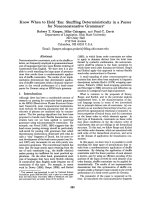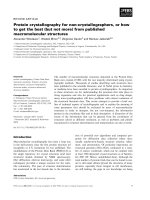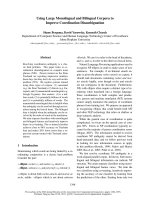báo cáo khoa học: " Diffuse large B-cell non Hodgkin’s lymphoma in a 65-year-old woman presenting with hypopituitarism and recovering after chemotherapy: a case report" pptx
Bạn đang xem bản rút gọn của tài liệu. Xem và tải ngay bản đầy đủ của tài liệu tại đây (802.54 KB, 4 trang )
CASE REP O R T Open Access
Diffuse large B-cell non Hodgkin’s lymphoma in a
65-year-old woman presenting with
hypopituitarism and recovering after
chemotherapy: a case report
Manohara Kenchaiah
*
and Steve L Hyer
Abstract
Introduction: Diffuse large B-cell non Hodgkin’s lymphoma may involve the pituitary either as a primary central
nervous system lymphoma or, more frequently, as metastasis from systemic lymphoma leading to hypopituitarism.
A partial recovery of pituitary function after treatment with chemotherapy has previously been described but
complete recovery with cessation of all hormone supplements is excessively rare. We report a patient presenting
with anterior hypopituitarism with subsequent complete and sustained recovery of pituitary function after
successful treatment of the lymphoma.
Case presentation: A 65-year-old Caucasian woman with lethargy, loss of appetite and peripheral edema was
found to have anterior hypopituitarism. Magn etic resonance imaging showed no mass lesions in the pituitary
although a positron emission tomography scan showed abnormal pituitary activity. An abdominal computed
tomography scan revealed multiple intra-abdominal lymph nodes, which on histology proved diagnostic of diffuse
large B-cell non Hodgkin’s lymphoma. She received six cycles of R-CHOP chemotherapy, after which she achieved
a complete metabolic response at all known previous sites of the disease, confirmed by positron emission
tomography scanning. Concomitant with the tumor response, there was full recovery of adrenal, thyroid and
gonadal axes which has persisted at 10 months follow-up.
Conclusion: Although rare, it is important to recognize lymphomatous infiltration of the pituitary as a potentially
reversible cause of hypopituitarism.
Introduction
Pituitary involvement of lymphoma either at presenta-
tion or late in the disease is rare. Patients with metasta-
sis of lymphoma to the pituitary usually present with
diabetes insipidus as the posterior lobe of the pituit ary
(unlike the anterior lobe) is supplied with blood directly
from the systemic circulation [1]. However, patients may
present with anterior pituitary failure either as a result
of tumor extension from the posterior pituitary or as
isol ated tumor deposits in the anterior pituitary [2]. We
now describe a patient presenting to our endocrine
department with anterior hypopituitarism which proved
fully reversible following successful chemotherapy.
Case presentation
A 65-year-old Caucasian woman presented with a six-
week history of lethargy and loss of appetite. She had
also noticed progressive pedal edema for a few weeks.
She had no significant past medical history. An initial
examination revealed that she was pale and hypotensive
(blood pressure 98/60 mmHg) with significant periph-
eral edema.
Her investigations rev ealed hyponatremia (118 mmol/
L), abnormal liver function tests with albumin 25 g/L,
alkaline phosphatase 244 units/L, alanine transaminase
61 units/L, aspartate transaminase 61 units/L, and pan-
cytopenia with hemoglobin 11 g/dL, white blood cell
* Correspondence:
Department of Endocrinology, Epsom & St Helier University Hospitals NHS
Trust, Surrey, SM5 1AA, UK
Kenchaiah and Hyer Journal of Medical Case Reports 2011, 5:498
/>JOURNAL OF MEDICAL
CASE REPORTS
© 2011 Kenchaiah and Hyer; licensee BioMed Central Ltd. This is an O pen Access article distributed under the terms of the Creative
Commons Attribution License ( , which permits unrestricted use, distri bution, and
reproduction in any medium, provided the original work is properly cited.
count 3.0 × 10
9
/L, platelet count 99 × 10
9
/L. A 250 μg
short tetracosatrin test showed cortisol results at 0 min-
ute of 93 nmol/L, 30 minutes of 43 nmol/L and 60 min-
utes of 315 mmol/L, suggestive of adrenal failure.
Baseline plasma adrenocortico tropic hormone was
reduced at 4 ng/L (reference range 10 ng/L to 40 ng/L)
in keeping with secondary hypoadrenalism. She was
started on hydrocortisone replacement and showed
slight improvement. Further endocrine tests showed
thyroid-stimulating hormone 0.35 mU/L, free thyroxine
7.1 pmol/L, free tri-iodothyronine less than 1. 7 pmol/L,
suggesting secondary hypothyroidism; follicle stimulating
hormone 6.3 U/L and luteinizing hormone 1.2 U/L,
indicating secondary hypogonadism; serum prolactin
343 mIU/L and serum insulin-like growth factor 1 34
nmol/L (normal range 6 nmol/L to 36 nmol/L). There
was no evidence of diabetes insipidu s. These tests were
interpreted as showing generalized anterior pituitary
dysfunction. Our patient received thyroxine replacement
in addition to hydrocortisone and was subjectively
improved. Even after steroids, there was no evidence o f
diabetes insipidus.
Magnetic resonance imaging (MRI) of her pituitary
(Figure 1) revealed no mass lesions in her pituitary. I n
view of her peripheral edema, an abdominal and pelvic
ultrasound was performed which revealed multiple
intra-abdominal lymph nodes, multiple solid liver lesions
and a 2 cm right groin lymph node (Figure 2). Full body
computed tomography (CT) confirmed the ultrasound
findings as well as identifying involvement of the base of
her skull. She underwent a biopsy from a right groin
lymph node, w hich showed reactive changes only. Sub-
sequently a liver biopsy was reported as showing a
highly malignant anaplastic tumor of unknown origin.
Our patient was referred to the local oncology unit
where histology was revi ewed. Immunophenotyping was
performed with C D19, CD20, CD22, CD79 and B-cell
lymphoma 2 and the diagnosis was confirmed as d iffuse
large B-cell non Hodgkin’ s lymphoma (Figure 3). A
positron emission tomography (PET) scan (Figure 4)
confirmed widespread disease including the p ituitary
(Stage 4).
Our patient received six cycles of chemotherapy with
rituximab, cyclophosphamide, vincristine, doxorubicin
and prednisolone (R-CHOP). Repeat PET scanning
showed a complete metabolic response at all known
previous sites of the disease (Figure 4).
Figure 1 T1-weighted MRI of her pituitary with contrast
showing normal appearances of pituitary (circled in red).
Figure 2 CT of her abdomen revealing multiple low density
opacities in the liver consistent with metastases.
Figure 3 Liver biopsy revealing infiltrates of large
lymphocytes, confirmed as large B-cell non Hodgkin
lymphoma on special staining (hematoxylin and eosin, original
magnification × 200).
Kenchaiah and Hyer Journal of Medical Case Reports 2011, 5:498
/>Page 2 of 4
At the same time, steroid and thyroxine replacement
doses were progressively withdrawn under close moni-
toring. There was full recovery of her adrenal, thyroid
and gonadal axes and she was off all medication and
clinically well when reviewed in the endocrine clinic 10
months after completing chemotherapy (see Table 1).
Discussion
WedescribeapatientwithdiffuselargeB-celllym-
phoma metastasizing to the anterior pituitary, in whom
pituitary function was restored after successful treat-
ment of the lymphoma. An early report of complete
resolution of non Hodgkin’ s lymphoma involving the
pituitary was based on
67
gallium scintigraphy and the
patient remained on hormone replacement [3]. More
recently, partial recovery of anterior hypopituitarism was
reported after successful chemotherapy but the patient
continued to require thyroxine [4]. Complete and persis-
tent pituitary recovery as in this case report is very rare.
Consistent with previous case reports [5,6], diffuse
large B-cell lymphomas are the commonest types of
lymphoma to involve the pituitary or central nervous
system. Primary pituitary lymphoma is exceedingly rare.
They usually present with headache, cranial nerve
abnormality and evidence of pituitary insufficiency [7].
By contrast, pituitary metastasis may be asymptomatic
presumably because of the pituitary’s large reserve capa-
city. When symptomatic, posterior lobe involvement is
BEFORE AFTER
B
A
D
C
Figure 4 PET scan imaging befor e and after six cycl es of R-CHOP. (A) PET scan before chemotherapy. Note multiple metabolically active
areas in the liver, axillae, neck and base of skull. (B) PET-CT scan before chemotherapy demonstrating widespread metastases in liver. (C) PET
scan after chemotherapy; complete resolution of metastases with only physiological appearances in gut. (D) PET-CT scan after chemotherapy
showing complete resolution of liver metastases.
Table 1 Endocrine investigations before/after R-CHOP chemotherapy
At presentation Four months after treatment Eight months after treatment
FSH (U/L) 6.3 25.1 38.8
LH (U/L) 1.2 16.0 25.8
9 a.m. Cortisol (nmol/L) 93 412 395
FT4 (pmol/L) 7.1 12.2 14.2
TSH (mU/L) 0.35 0.5 0.5
LH: luteinizing hormone; FSH: follicle stimulating hormone; FT4: free thyroxine; TSH: thyroid-stimulating hormone
Kenchaiah and Hyer Journal of Medical Case Reports 2011, 5:498
/>Page 3 of 4
more common, but isolated anterior pituitary dysfunc-
tion was present in six of a series of 13 patients pre-
viously reported [8].
Typically, MRI reveals a pituitary mass which on T1-
and T2-weighted images is either iso- or hypodense and
enhances with contrast [9]. Unlike other brain tumors,
T2-prolongation is not present owing to the dense cellu-
larity and high nucle us to cytoplasm ratio of lymphoma
[10]. In patients with posterior pituitary involvement,
there is typically absence of the pituitary bright spot. In
our patient, the pituitary magnetic resonance image was
normal, which we presume indicates a diffuse infiltration
by lymphoma cells rather akin to a hypophysitis with
infiltrating lymphocytes.
Differentia l diagnosis of a pituitary mass has been well
described previously [2]. In a patient with a normal
pituitary image and anterior hypopituitarism, the differ-
ential includes other infiltrative processes including sar-
coidosis and hypophysitis.
Our patient was not subjected to a pitu itary biopsy as
we felt we had sufficient evidence of lymphomatous
infiltration of the pituitary based on clinical findings,
histology from liver and lymph nodes and PET scan
results. Pituitary lymphomas are described as firm, vas-
cular and adherent to surrounding structures and need-
ing piecemeal dissection. This is in contrast to necrotic
adenomas which are typically soft [9]. In our patient,
the simultaneous improvement in pituitary function
with tumor response to chemotherapy was also highly
suggestive.
Prognosis in previous reported series ranges between
nine weeks after presentation to greater than 20 years
[5]. Prognostic factors include age, comorbidity and his-
tology at presentation. However widespread lymphoma,
as in our patient, is not, in itself, indicative of poor
prognosis.
Conclusion
We report a patient with diffuse large B-cell non Hodg-
kin’ s lymphoma with anterior pituitary involvement,
whose pituitary function recovered with successful che-
motherapy. A complete metabolic response was induced
as reflected by the PET scan imaging and no abnormal
activity is now present in the pituitary. Unusually, the
pituitary was not enlarged on imaging and we sp eculate
that the infiltration behaved like a hypophysitis and
completely resolved with chemotherapy. At follow-up,
our patient is well and off all medication, 10 months
after initiation of chemother apy. Early diagnosis is
important as aggressive disease is potentially rapidly
fatal and treatment can be effective.
Consent
Written informed consent was obtained from the patient
for publication of this case report and any accompany-
ing images. A copy of the written consent is available
for review by the Editor-in-Chief of this journal.
Funding
No funding was received in the preparation of this
report
Authors’ contributions
MK collected data, performed the literature search and wrote the first draft
of the manuscript. SH supervised the project, reviewed literature and revised
the manuscript. Both authors read and approved the final manuscript.
Competing interests
The authors declare that they have no competing interests.
Received: 17 June 2011 Accepted: 4 October 2011
Published: 4 October 2011
References
1. Branch CL, Laws ER: Metastatic tumors of sella turcica masquerading as
primary pituitary tumors. J Clin Endo Metab 1987, 65(3):469-474.
2. Freda P, Post KD: Differential diagnosis of sellar masses. Endocrinol Metab
Clin North Am 1999, 28(1):81-111.
3. Jonkhoff AR, Huijgens PC, Schreuder WO, Teule GJJ, Heimans JJ:
Hypophyseal non-Hodgkin’s lymphoma presenting with clinical
panhypopituitarism successfully treated with chemotherapy. J
Neurooncol 1993, 17(2):155-158.
4. Wolfe SQ, Hood B, Barker J, Benveniste RJ: Primary CNS Lymphoma
mimicking pituitary apoplexy: case report. Pituitary 2009, 12(1):76-79.
5. Ogilvie CM, Payne S, Evanson J, Lister TA, Grossman A: Lymphoma
metastasizing to pituitary: an unusual presentation of treatable disease.
Pituitary 2005, 8(2):139-146.
6. Basaria S, Krop J, Braga-Brasaria M: A rare case of pituitary stalk
enlargement and panhypopituitarism. Mt S J Med 2003, 70(4):265-267.
7. Landman RE, Wardlaw SL, McConnell RJ, Khandji AG, Bruce JN, Freda PU:
Pituitary lymphoma presenting as fever of unknown origin. J Clin Endo
Metab 2001, 86(4):1470-1476.
8. Li J, Chow C, Yeung V, Ko G, Cockram CS: Adrenal and hypophyseal non-
hodgkin’s lymphoma presenting as panhypopituitarism. In J Clin Pract
1998, 52(7):513-514.
9. Kaufmann TJ, Lopez BS, Laws ER, Lipper MH: Primary sellar lymphoma:
Radiologic and Pathologic findings in two patients. Am J Neuroradiol
2002, 23(3):364-367.
10. Erdag N, Bhorade RM, Alberico RA, Yousuf N, Patel M: Primary lymphoma
of central nervous system: typical and atypical CT and MRI appearances.
AJR Am J Roentgenol 2001, 176(5):1319-1326.
doi:10.1186/1752-1947-5-498
Cite this article as: Kenchaiah and Hyer: Diffuse large B-cell non
Hodgkin’s lymphoma in a 65-year-old woman presenting with
hypopituitarism and recovering after chemotherapy: a case report.
Journal of Medical Case Reports 2011 5:498.
Kenchaiah and Hyer Journal of Medical Case Reports 2011, 5:498
/>Page 4 of 4









